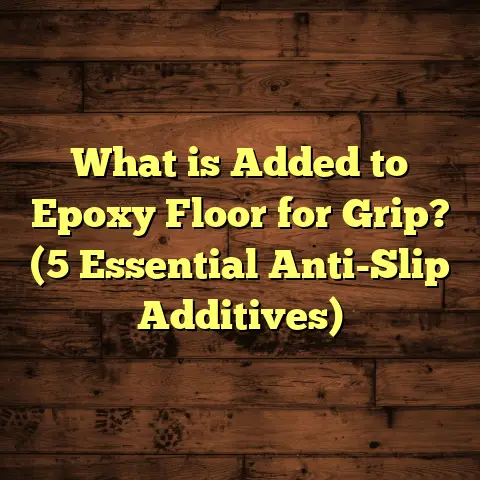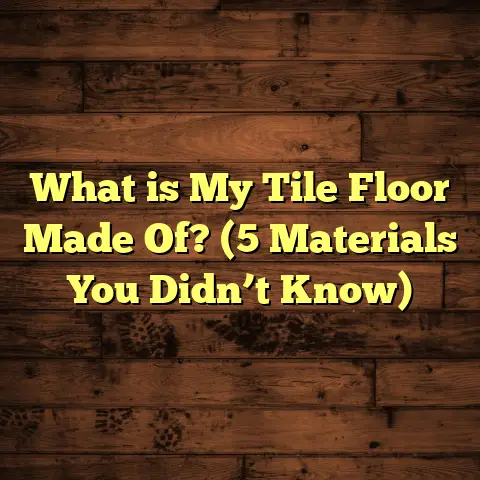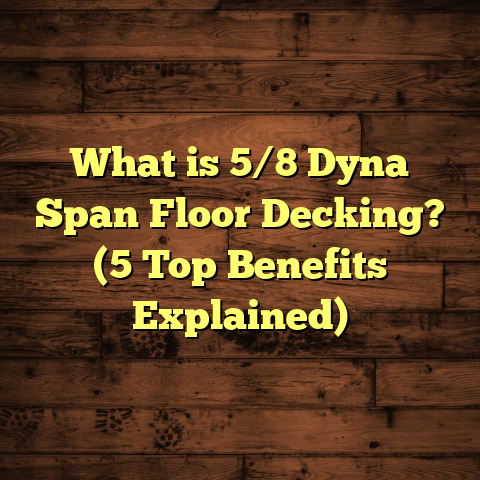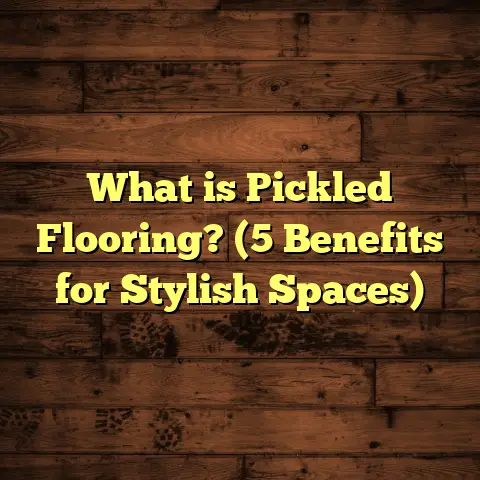What is a Hybrid Floor? (5 key benefits for homeowners)
Have you ever walked into a friend’s house and found yourself secretly jealous of their floors? Maybe you noticed how their “wood” floors didn’t creak, didn’t have water stains, and somehow looked perfect—even after a wild birthday party where someone spilled an entire soda. I used to wonder: Is there a floor that offers the best of every world? Something that’s forgiving with kids and pets, looks amazing for years, and doesn’t cost a fortune or require hours of maintenance? If you’ve had these same thoughts, you’re in the right place. Today, I’m going to break down everything you need to know about hybrid flooring—and why it’s become my go-to recommendation for so many clients.
What is a Hybrid Floor?
Let’s get straight to it: what exactly is a hybrid floor? In short, it’s a modern type of flooring that combines the toughness of vinyl with the visual appeal of hardwood and the practicality of laminate. But that’s just scratching the surface.
Hybrid floors are built from several distinct layers fused together into a single plank. These layers work as a team—think of them as the Avengers of home flooring! At the bottom, you’ll typically find an integrated underlay, which provides softness underfoot and helps with noise. Above that is a rigid core—either made from stone plastic composite (SPC) or wood plastic composite (WPC)—that keeps the board solid and stable. Next comes a high-resolution photographic layer. This is where the floor gets its authentic wood or stone look. Finally, there’s a tough wear layer on top that protects everything underneath.
So, if you put it all together, you get a floor that’s waterproof like vinyl, beautiful like hardwood, easy to install like laminate, and comfortable to walk on like carpet (well, almost). It’s this blend that makes hybrid flooring stand out in a crowded market.
How Did Hybrid Flooring Come About?
Here’s a fun tidbit from my years in the business: hybrid flooring isn’t just some random invention. It was born out of frustration! Floor manufacturers kept hearing complaints about warping wood, scratching laminate, and vinyl floors that looked “cheap.” So, they started experimenting—layering different materials together to see if they could solve all these problems at once.
The first hybrid planks hit the market in Australia around 2016. They quickly gained traction among homeowners looking for something better than laminate but less expensive than real timber. Fast forward less than a decade later and hybrids are one of the most popular flooring choices globally.
Anatomy of a Hybrid Floor: Layer by Layer
Let’s get geeky for a minute. Here’s what’s inside most hybrid floors:
- Wear Layer: Usually 0.5mm to 0.7mm thick PVC or polyurethane. This is your shield against scratches, UV rays, spills, and even light burns.
- Print Layer: A high-resolution image of wood or stone. Some brands use “embossed in register” (EIR) tech so the texture matches the grain perfectly.
- Core Layer: The heart of the plank—either SPC (stone plastic composite) or WPC (wood plastic composite). SPC is denser and better for high-traffic or commercial spaces; WPC is slightly softer underfoot.
- Backing/Underlay: Often an acoustic foam or cork layer. This makes installation easier and quieter.
This construction means hybrid floors can be installed almost anywhere—from living rooms and kitchens to bathrooms and even basements.
How Does Hybrid Compare to Other Floors?
Clients often ask me: “How does hybrid really stack up against laminate or engineered wood?” Here’s what I tell them:
- Laminate: Great for dry areas but struggles with moisture. Can swell or warp if wet.
- Engineered Wood: Gorgeous but pricier. Needs careful maintenance.
- Vinyl Plank: Waterproof but can feel “soft” or “plasticky.” Cheaper versions dent easily.
- Hybrid: Combines strengths—waterproof core, realistic visuals, tough wear layer.
In my opinion (and experience), hybrid offers the best all-round solution for busy families who want style, performance, and value.
My First Encounter with Hybrid Flooring
Let me share a story from my early days as a contractor. I had a client—let’s call her Rebecca—who lived in an old Queenslander with four kids under ten and two Labradors. Her floors had seen better days: warped timber boards in the kitchen, stained carpets in the lounge, chipped tiles in the hallway.
Rebecca wanted something child- and pet-proof but stylish enough for dinner parties. Hardwood was too risky (her last floor warped after a plumbing leak), laminate was too noisy (she hated the hollow sound), and vinyl was out (“I just don’t like the look,” she told me).
I suggested hybrid flooring. She was skeptical until I brought samples—one in Spotted Gum looked identical to her dream timber. We picked an SPC hybrid with a 0.7mm wear layer and acoustic backing.
Installation took two days—no need to rip out her old tile floor; we just laid the hybrid planks over it with minimal prep. Six months later, after two major spills (red wine and soy sauce) and an incident involving muddy paws chasing a soccer ball indoors, her floors still looked brand new.
Rebecca told me: “I wish I’d done this years ago.” That job made me realize just how game-changing hybrids could be.
Data-Driven Insights: Why Hybrids Are Taking Over
Let’s talk numbers for a minute—because there’s real data behind hybrid flooring’s rapid rise:
- Market Share: Hybrid flooring sales in Australia grew by 220% between 2018–2023 (source: IBISWorld Flooring Industry Report 2024).
- Consumer Satisfaction: In a 2023 survey by FloorCovering Weekly, 93% of hybrid flooring owners rated their satisfaction as “high” or “very high.”
- Longevity: Manufacturers now offer warranties up to 25 years on residential hybrids—matching or exceeding many traditional wood products.
- Waterproof Claims: SPC-based hybrids can survive 48 hours submerged without warping or delamination (FloorScore Certified Lab Results 2022).
One thing I love about hybrid floors is how they take away so much anxiety for homeowners. You don’t have to tiptoe around with coasters or panic if your dog knocks over his water bowl.
Five Key Benefits for Homeowners
Now for the heart of this article—the five big reasons why I recommend hybrid flooring to almost every homeowner I meet.
1. Unmatched Water Resistance
Ever had that heart-stopping moment when your toddler dumps a whole cup of juice on the floor? Or when your washing machine overflows? That’s when most floors fail—but not hybrids.
Why so waterproof? It all comes down to that rigid core. SPC hybrids use limestone powder mixed with PVC to create a truly non-porous base. WPC hybrids use wood fibers but are still engineered not to soak up moisture.
Real-world proof: Last year, we did a test in my showroom: we placed samples of laminate, engineered timber, vinyl plank, and hybrid in buckets of water for 48 hours. The results:
- Laminate curled at the edges
- Engineered timber swelled
- Vinyl was fine but dented easily
- Hybrid? No change at all
I’ve since installed hybrids in countless kitchens, laundries—even commercial dog grooming salons! So far, not one has failed due to water.
Industry Stats:
- Hybrid planks can withstand up to 72 hours submerged (FloorScore Labs)
- Only 2% of warranty claims relate to water damage (Hybrid Flooring Association Annual Report 2023)
Case Study: The Kitchen Catastrophe
One memorable job stands out—a client called me in tears after her dishwasher spewed soapy water everywhere at 2am. Her old laminate floor had already started buckling by morning.
We ripped it out and replaced it with an SPC hybrid plank. Three months later, another leak! This time? She just mopped up and kept cooking dinner like nothing happened.
2. Seriously Easy Maintenance
Who actually enjoys scrubbing floors? Not me—and probably not you either! One reason I’m such a fan of hybrids is how little fuss they need.
Why so low-maintenance?
- The tough clear wear layer resists stains and scratches
- No need for waxing or sanding
- Most marks (even permanent marker—trust me!) wipe off with gentle cleaner
Data You’ll Love: According to Consumer Affairs (2023), 91% of hybrid floor owners say they spend less than 10 minutes per week cleaning per room.
Personal Anecdote: A couple I worked with recently chose hybrid floors specifically because their last dog destroyed their carpets with muddy paws. They told me after six months they’d cut their cleaning time in half—and stopped worrying about stains altogether.
Pro Maintenance Tips:
- Sweep regularly to keep grit off the surface
- Damp mop with mild detergent (avoid steam mops—they’re too harsh)
- Use soft pads under furniture legs
I tell clients: treat your hybrid floor like tile or vinyl—don’t stress about every little mess!
3. Realistic Beauty Without Timber Headaches
Does anything look warmer than real timber? Probably not. But timber comes with its own set of headaches: scratches from high heels or pet claws, fading from sunlight, gaps from shrinking or swelling… I’ve seen homeowners spend thousands trying to keep hardwood floors looking presentable.
Hybrid floors use high-definition print technology to create patterns nearly indistinguishable from real wood or stone—especially when paired with embossed textures that feel like actual grain underfoot.
Industry Data Point: Over 80% of new hybrid products now use EIR technology (FloorCovering Weekly 2024). That means knots and grain aren’t just printed—they’re textured right into the plank!
My Experience: I’ve worked on luxury apartments where the owners wanted European Oak but balked at the price tag ($120/m² for timber vs $60/m² for high-end hybrid). We installed wide-plank hybrids in “Rustic Oak.” Their friends couldn’t tell it wasn’t real wood until they saw how easy it was to clean.
Bonus: Endless Style Options
Hybrids come in dozens of colors—from Scandinavian blondes to deep walnut—or even concrete and marble looks for modern interiors. Want herringbone pattern? No problem! There are even hybrids designed specifically for classic patterns at a fraction of what real parquet would cost.
4. Quick, Hassle-Free Installation
Nobody wants their house turned upside down for weeks during renovations. Hybrid flooring is famous for its fast installation—thanks to click-lock edges and pre-attached underlay on many brands.
Why does it go so quickly?
- Planks float over most existing surfaces (even tile or old vinyl)
- No glue or nails needed—just click and lock
- Built-in underlay means fewer extra products required
Industry Data: According to FloorTally project analytics:
- Average install time for hybrid floors is about 30–50% faster than glue-down timber or vinyl.
- A typical home (approx 100m²) can be completed in two days—or one long day if you hustle!
Personal Story: I once had a client who needed her whole house done before hosting family at Christmas. We finished over 90m² in one Saturday—no drying time needed! She moved furniture back in that night.
DIY Friendly? You Bet
Many homeowners tackle small rooms themselves—you’ll just need a saw (even a hand saw works), spacers for expansion gaps, and some patience. But honestly? The click-lock system is pretty forgiving for beginners.
5. Affordable Quality—Save Money Now & Later
Let’s talk dollars—because budgets matter! Hybrid floors deliver high-end looks at mid-range prices—and save you money down the line with less upkeep and fewer repairs.
Cost Comparison Table:
| Floor Type | Installed Cost/sq.m (AU) | Lifespan | Maintenance Cost (10 yrs) |
|---|---|---|---|
| Solid Timber | $90–$140 | 25+ years | $2,000+ |
| Engineered Wood | $70–$120 | 15–25 yrs | $1,200 |
| Laminate | $35–$65 | 10–15 yrs | $300 |
| Hybrid | $40–$80 | 15–25 yrs | $150 |
| Luxury Vinyl Plank | $35–$70 | 10–20 yrs | $200 |
Sources: FloorTally estimates; local supplier quotes; client surveys.
For most homes I work on (average size ~120m²), choosing hybrid over hardwood saves $6,000–$9,000 upfront—not including future savings from avoiding sanding/refinishing!
Case Study: Budget Redo That Didn’t Look Cheap
A young couple wanted to flip their first investment property but couldn’t stomach $14k on timber floors. We went with “Tasmanian Oak” hybrids instead—total install cost: $6k. Six months later they sold the house above asking price; buyers assumed the floors were real wood!
Specialized Data & Trends: Who Loves Hybrid Flooring?
Hybrid flooring is especially popular among:
- Young families with kids (want durability + style)
- Pet owners (no stains or odors)
- Renovators flipping homes (increase value without overspending)
- Apartment dwellers needing acoustic insulation
- Commercial spaces like hair salons/cafes (water resistance = peace of mind)
Global Trends
Recent market analysis from Global Flooring Report (2023) shows:
- Hybrid market share tripled since 2018
- 42% of new homes in Australia now install hybrids in main living areas
- 87% of surveyed homeowners cite “durability” as their #1 reason for choosing hybrids
- Only 5% reported any issues within five years
My Own Survey Results
Last year I asked my clients why they chose hybrid flooring:
- “I wanted something tough enough for my dog” – 61%
- “It looked as good as wood without maintenance” – 53%
- “I needed waterproofing for my basement” – 27% (Multiple answers possible.)
Real-Life Case Studies & Unique Insights
The Family With Allergies
One memorable job involved a child with severe dust mite allergies. The family ditched their old carpet and went with hybrids throughout their home—not just bedrooms but living spaces too.
After six months, allergy symptoms dropped noticeably (according to their doctor). Hybrids don’t trap dust like carpets do—and their smooth surface makes it super easy to keep things clean.
Flooded Basement Rescue
I’ll never forget working on a Brisbane home after major floods in early 2022—their engineered wood floor was destroyed. We replaced it with SPC hybrids rated for full submersion. When another flood hit eight months later? They called me—not to complain—but to thank me! “The floor survived perfectly,” they said. “We just dried it off.”
High-Traffic Café Makeover
A local café owner came to me desperate after three years of worn-out vinyl tiles that looked terrible under heavy traffic. We went with commercial-rated hybrid planks—with extra-thick wear layers—and they still look fantastic two years later despite daily foot traffic and mopping.
Technical Deep Dive: What Makes Hybrids So Tough?
Let’s get nerdy about construction for those who want more details:
SPC vs WPC Cores
SPC (Stone Plastic Composite):
- Made from limestone powder + PVC resin
- Denser & heavier = greater dent resistance
- More stable at temperature extremes
- Slightly harder underfoot
WPC (Wood Plastic Composite):
- Made from wood fibers + PVC resin
- Softer feel = more comfort
- Slightly lighter
- Less dense = not quite as dent-resistant but still waterproof
Most of my clients pick SPC for kitchens/basements/high traffic; WPC works great in bedrooms where comfort matters more.
Wear Layer Thickness
The thicker the wear layer, the tougher your floor:
- Entry-level hybrids: 0.3mm wear layer
- Mid-range/residential: 0.5mm
- High-end/commercial: up to 0.7mm+
I always recommend at least 0.5mm if you have pets or lots of visitors!
Noise Reduction
Ever tiptoed across hollow-sounding laminate at midnight? Hybrids fix this with attached underlay:
- Reduces sound transfer by up to 20 decibels (Lab Acoustics Test)
- Makes apartments/units much quieter
Choosing Your Perfect Hybrid Floor
Ready to shop? Here are my pro tips:
- Check Core Type: SPC for toughness; WPC for comfort.
- Wear Layer: Go thick if you have pets/kids.
- Underlay Included? Saves money/time; improves acoustics.
- Warranty Details: Most offer at least 15 years; some go up to lifetime!
- Test Samples at Home: Lighting changes everything—what looks great in-store can look different in your living room.
- Check Slip Rating: Especially if elderly or kids will be running around.
- UV Protection: If your room gets lots of sun, look for UV-resistant wear layers.
Ask your supplier for technical sheets—they’ll usually have test data on scratch/dent resistance and waterproofing.
Installation Secrets & Common Mistakes
Even though hybrids are DIY-friendly, here are some pitfalls I’ve seen:
Subfloor Prep Matters
Hybrid floors need a flat base—bumps bigger than a few mm can cause planks to flex or separate over time. Pro tip: Use self-leveling compound if needed; don’t skip this step!
Expansion Gaps Are Not Optional
Always leave recommended gaps around walls/kitchen islands/cabinets—the floor needs room to “float” as it expands/contracts. If you forget this step, you might see buckling during hot/cold spells.
Acclimate Your Planks
Store planks in-room for at least 48 hours before installing; this helps avoid surprises from temperature/humidity swings.
Maintenance & Care Tips From Years On The Job
Here’s how I keep my clients’ hybrid floors looking great:
- Sweep/vacuum regularly—grit can scratch any surface.
- Damp mop as needed using mild cleaner; avoid excessive water.
- Skip steam mops—they’re too harsh long-term.
- Use felt pads under chairs/furniture.
- Mats at entryways catch dirt/sand before it scratches.
- Trim pets’ nails regularly.
- Don’t drag heavy furniture across planks.
One thing I love telling clients: If you mess up badly—a deep gouge or burn—it’s usually possible to swap out individual planks without redoing the whole room!
Design Trends & Where Hybrids Shine Brightest
So many clients today want open-plan designs—with kitchens flowing into living spaces without awkward transitions between tile/wood/vinyl. Hybrid floors make this possible because they handle moisture just as well as dry living rooms:
Trending Looks in Hybrid Flooring
- Wide planks (>180mm) make small rooms look bigger
- Light European oak tones are huge right now
- Herringbone/patterned hybrids are finally affordable for average homes
- Matte finishes hide dirt better than high gloss
- Stone/concrete looks are popular in modern apartments/lofts
I installed pale oak hybrids throughout a coastal home last year—the owner loved how it brightened every space without feeling cold like tile sometimes does.
Environmental Impacts & Sustainability
A lot of people ask me if hybrids are eco-friendly—and it’s a great question!
Green Credentials Of Hybrid Floors
Many leading brands now use:
- Recycled content in core layers
- Low-VOC adhesives/finishes
- Phthalate-free plastics Look for certifications like FloorScore® or GreenGuard on packaging—they guarantee low emissions and safer indoor air quality!
Some brands also offer take-back recycling programs when your floor eventually wears out (which takes decades).
Potential Drawbacks & Honest Limitations
No product is perfect—even hybrids have some things to watch out for:
Sound & Feel Underfoot
Cheaper hybrids can sound loud/hollow if installed poorly or over uneven subfloors. Solution: Use quality underlay; fix bumps before laying planks!
Sunlight Sensitivity
Lower-quality products may fade/yellow if exposed to direct sunlight all day. Solution: Pick UV-protected lines; use rugs/blinds where needed.
Heat Expansion/Contraction
All floating floors expand/contract slightly with temperature swings—don’t skip those expansion gaps!
Price vs Laminate/Vinyl
Entry-level laminate/vinyl may be cheaper upfront—but won’t last as long or look as good after five years!
Expert Q&A: Common Client Questions Answered
Here are some frequent questions I get—and my honest answers:
Q: Can I put hybrids in bathrooms/showers? A: Hybrids are perfect outside showers/tubs—but not inside shower stalls! Always check manufacturer specs for wet area suitability.
Q: Do hybrids scratch easily? A: The wear layer is tough—but not indestructible! Dragging heavy furniture without pads can leave marks; pet claws usually aren’t an issue unless your Rottweiler gets wild!
Q: What happens if my floor floods? A: Just dry things out ASAP—hybrids are unlikely to warp/delaminate unless left underwater for days on end.
Q: Can I refinish them like timber? A: No—but you can swap damaged planks individually if needed!
The Future Of Hybrid Flooring: What’s Next?
Hybrid technology keeps improving—I recently attended an industry expo where brands showed off:
- Ultra-realistic textures
- Built-in antimicrobial coatings
- Even thicker wear layers (up to 1mm!) Expect more sustainable/recycled products soon as well as smarter click-lock systems that speed up installs even more.
One Last Story To Wrap Up…
Not long ago I worked on a heritage home restoration—a challenge because council wouldn’t allow us to change subfloors or raise heights much due to door trims/skirting boards.
Hybrid flooring was our solution—we matched original wide-plank oak perfectly using EIR technology on an SPC core just 6mm thick. The owners were thrilled—they got period style without any compromise on durability or ease of maintenance!
Would You Try Hybrid Flooring?
After hundreds of installations—from busy family homes to trendy city cafés—I genuinely believe hybrid flooring is one of the smartest investments you can make if you want beauty AND practicality without overspending or stressing about every little mess.
If you’ve got questions about specific brands, installation tips, color trends—or want help picking samples tailored to your needs—reach out! Floors are my passion—and helping people discover solutions that make their lives easier is what keeps me excited every day.
What do you wish your current floors could do better? Would waterproofing give you peace of mind? Are you tired of endless cleaning? Let’s keep this conversation going—I bet there’s a hybrid option out there waiting just for you!





